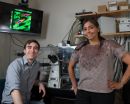(Press-News.org) Researchers from Intermountain Medical Center in Salt Lake City have identified a new "sliding scale" model used to rule out potentially deadly blood clots in the lungs, known as pulmonary embolisms, that is more accurate than current diagnostic methods.
The new model, which factors in a patient's age, more accurately identifies a patient's risk of the often-deadly blood clots and can more easily rule out the need for additional, more invasive tests, helping to reduce unnecessary costs.
The research is published in the medical journal, CHEST.
Pulmonary embolism is associated with more deaths annually than breast cancer, HIV/AIDS, prostate cancer, and motor vehicle accidents combined, which means it's important to get its diagnosis right so the proper treatment can be instituted.
"When patients come to the ER with the symptoms of a pulmonary embolism, we begin by doing a physical exam and identifying their previous medical history," said Scott Woller, MD, co-director of Intermountain Medical Center's Thrombosis Program, and the study's lead author. "Once we get that initial information, we often conduct a simple blood test called a d-dimer, which tests for proteins found in the blood when a clot is present. If the protein levels are above a certain threshold, we most often order a CT scan to confirm or rule out a pulmonary embolism. However, as we age, d-dimer levels naturally increase, which means when we test d-dimer in elderly patients, we often find an elevated result--even when a clot is absent. This is referred to as a false positive test."
The study identified more than 900 patients who came to an emergency department with symptoms of a pulmonary embolism and for whom d-dimer tests were ordered. Researchers determined that adjusting the threshold of d-dimer levels in correlation to a patient's age would accurately exclude a pulmonary embolism diagnosis without requiring the patient to receive additional testing.
The conventional cutoff used to identify a normal d-dimer value is 500. The new research suggests that patients older than 50 should have the cutoff adjusted upward to a value equal to the patient's age multiplied by 10. For example, a 72-year-old patient would have a normal d-dimer value of less than 720.
"A CT scan is most often used to ultimately rule out a pulmonary embolism, however it delivers radiation to the patient and contrast dye," said Dr. Woller. "Elderly patients are at greater risk for inadvertent harm related to the CT scan, and the contrast dye may also impact kidneys function, plus the scan adds to the cost of the patient's care. If we can safely and accurately diagnose the patient's risk of a pulmonary embolism using this sliding d-dimer scale, we can eliminate the need for additional imaging tests."
Dr. Woller's research demonstrates that among patients older than 50, adoption of the age-adjusted cutoff would decrease the number of CT scans that would need to be performed by nearly 20 percent.
The sliding scale is currently being studied further, but the initial research adds to a growing body of evidence that this simple change may be a safe and efficient way to exclude the diagnosis of pulmonary embolism in a great number of patients.
INFORMATION:
Intermountain Medical Center is the flagship medical facility for the nationally-recognized Intermountain Healthcare system, based in Salt Lake City.
The engineered spring flood that brought water to previously dry reaches of the lower Colorado River and its delta resulted in greener vegetation, the germination of new vegetation along the river and a temporary rise in the water table, according to new results from the binational team of scientists studying the water's effects.
The experimental pulse flow of water was the result of a U.S.-Mexico agreement called Minute 319.
"The pulse flow worked," said Karl W. Flessa, co-chief scientist for the Minute 319 Science Team. "A small amount of water can have a big effect ...
New research helps explain a paradoxical effect of certain antidepressants--that they may actually worsen symptoms before helping patients feel better. The findings, highlighted in a paper publishing online December 17 in the Cell Press journal Trends in Cognitive Sciences, may help investigators fix the problem as well as create new classes of drugs to treat depression.
Selective serotonin reuptake inhibitors (SSRIs) are the most widely prescribed class of antidepressant drugs, and they work by increasing levels of a brain chemical called serotonin. While this boost ...
In an article to be published in the January issue of BioScience, two philosophers tackle one of the most divisive arguments in modern biology: the value of the theory of "kin selection."
Kin selection is the idea that because genes influence behavior, and because an animal that helps its relatives helps to spread genes likely identical to its own, animals will evolve to favor kin. Researchers have spent decades testing this explanation for apparent animal altruism, but in recent years, critics, notably Martin Nowak of Harvard University and the famous naturalist and ...
(PHILADELPHIA) - Researchers look to understand the causes of amyotrophic lateral sclerosis (ALS), in the hope of finding new ways to treat the disease. A new study published online today (December 17th) in the Cell Press journal Neuron shows that a common gene mutation in ALS generates a deadly protein that may cause the damage in the brain that leads to ALS.
About 5 percent of ALS patients carry an altered version of a gene called C9orf72, which in ALS patients contains hundreds of repeat sequences that otherwise are not present in normal individuals. Since the gene's ...
When faced with making choices, but lack sufficient evidence to guarantee success, our brain uses elapsed time as a proxy for task difficulty to calculate how confident we should be, a team of neuroscientists has found. Their findings, which appear in the journal Neuron, help untangle the different factors that contribute to the decision-making process.
"In our daily lives, we make many decisions," says Roozbeh Kiani, an assistant professor in NYU's Center for Neural Science and one of the study's authors. "Sometimes the evidence afforded us is strong, enabling us to ...
More than 90 percent of cancer-related deaths are caused by the spread of cancer cells from their primary tumor site to other areas of the body. A new study has identified how one important gene helps cancer cells break free from the primary tumor.
A gene normally involved in the regulation of embryonic development can trigger the transition of cells into more mobile types that can spread without regard for the normal biological controls that restrict metastasis, the new study shows.
Analysis of downstream signaling pathways of this gene, called SNAIL, could be used ...
PITTSBURGH--A stream runs through it. A much nicer, healthier stream.
Pittsburgh's Frick Park is home to Nine Mile Run, a stream that had been known as "Stink Creek." From 2003 to 2006, the City of Pittsburgh and the U.S. Army Corps of Engineers poured $7.7 million into restoring 2.2 miles of the stream and tributaries into waterways approximating what they were prior to urban development.
The project remains one of the largest urban-stream restorations undertaken in the United States.
What can this restoration teach us as we continue to deal with streams affected ...
WASHINGTON - National Poison Control Center data from 2012 show that poisonings from prescription drugs are the leading cause of injury death in the United States, and that poisonings from "bath salts," synthetic marijuana and laundry detergent pods are emerging threats to public health. The paper was published online Monday in Annals of Emergency Medicine ("Poisoning in the United States: 2012 Emergency Medicine Report of the National Poison Data System").
"The poison center system can provide real-time advice and collect data regarding a variety of poisonings, including ...
WASHINGTON -- Two related proteins exert a lethal double whammy effect against glioblastoma cells when activated with a small molecule, say researchers at Georgetown Lombardi Comprehensive Cancer Center.
The scientists say when activated, one protein, called the short form, stops glioblastoma cells from replicating their DNA, and the other, called the long form, prevents cell division if the DNA has already been replicated, explains Rebecca Riggins, PhD, assistant professor of oncology at Georgetown Lombardi. The study was posted online Dec. 12 in the journal Cell Cycle.
Both ...
New Rochelle, NY, December 17, 2014-The Sunni Islamist terror organization known as the Islamic State, or ISIS, uses extreme violence and brutality against anyone it perceives as a threat to its goal of expansion and restoration of an Islamic Caliphate. The significant behavioral aspects of this unparalleled violence and its implications for the future are explored in a compelling Review article published in Violence and Gender, a peer-reviewed journal from Mary Ann Liebert, Inc., publishers. The article is available free on the Violence and Gender website at http://online.liebertpub.com/doi/full/10.1089/vio.2014.0037 ...


